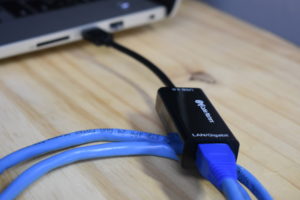Resourceful
Some laptops don’t come with an Ethernet jack, so having an USB-to-Ethernet converter comes in handy.
Last updated March 2019
Disclaimer
ProteShea, LLC is a participant in the Amazon Services LLC Associates Program, an affiliate advertising program designed to provide a means for sites to earn advertising fees by advertising and linking to Amazon.com
Some links may be affiliate links, in which ProteShea, LLC earns a commission if you use that affiliate link. Please note that this is at no additional cost to you and helps us in creating more content.
Smaller, cheaper, lighter, power efficient, high performance. These are the buzzwords that laptop manufactures live by. They heavily invest in ways to make their computers meet these demanding specifications to stay on top of their competition. What does using an USB-to-Ethernet adapter have to do with this? In order to make laptop chassis thinner, some designers have gotten rid of the Ethernet jack. You can still connect your laptop via Ethernet, but you’ll need a Type A or Type C USB-to-Ethernet adapter.

The Thickness of a Laptop Chassis
Take a look at an old laptop. What are the biggest connectors on it? The VGA and Ethernet connectors. These usually dictate the thickness of the laptop chassis. For example, the VGA connector on my old Dell laptop is about 1/2” thick and therefore, the thickness of the chassis is around 1” to be able to accommodate that. Over the years, we’ve slowly found laptop manufacturers phase out the VGA connector by replacing it with an HDMI connector. Okay, but how do you replace the Ethernet connector? We all love super fast connection speeds. You design a clever jack like the one in fig. 1. or you use the USB-to-Ethernet adapter.

Compatibility
The USB-to-Ethernet adapters are plug and play, at least on a computer running a Windows operating system. I’m not sure how user-friendly they are on macOS or any Linux distribution. For an embedded system that doesn’t have an Ethernet jack, but does have an USB connector, it might not work. Usually you have to install a driver or write your own to be able to handle Ethernet traffic via USB.
Use Case
If you do have an Ethernet jack, it’s still handy to have an adapter. Let’s say you don’t want to share your bandwidth with other devices on an Ethernet switch and you want to plug your desktop directly into the port on your WiFi router. (Take a look at Twin Insight #11 about using an Ethernet switch). By doing so, you cannot connect other devices since your only Ethernet port is taken. In this case, you would have to use the adapter. There are plenty of USB jacks on your desktop or laptop.
What did we learn?
- Laptop manufacturers get rid of bulky connectors to make their chassis smaller and lighter.
- Use an USB-to-Ethernet adapter in lieu of an Ethernet jack directly on your laptop.